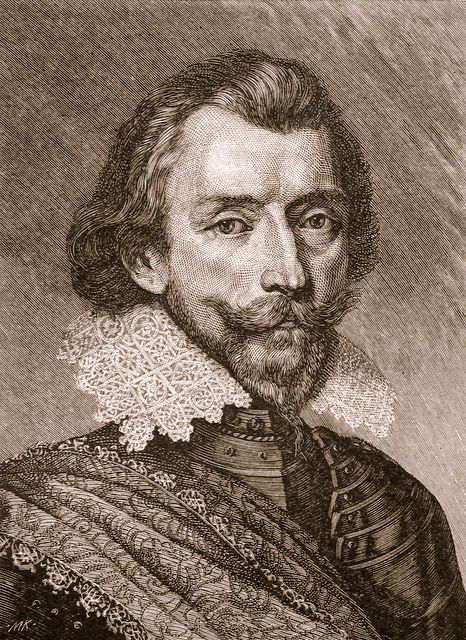German mercenary and military commander during the early years of the Thirty Years’ War (1618–1648). Peter Ernst Mansfeld was the illegitimate son of Graf (Count) Peter Ernst I, Prince von Mansfeld, imperial governor of Luxembourg. Although Emperor Rudolf II (r. 1576–1612) legitimized the younger Mansfeld, he was specifically excluded from inheriting any of his father’s estates.
Mansfeld entered imperial service and distinguished himself in fighting in Hungary, campaigning under his half brother Charles (1543–1595), also a soldier of note who held a prominent command in the imperial forces. Probably from spite for being excluded from what he regarded as his rightful inheritance, Mansfeld switched allegiances and fought on the side of the Protestant princes who did battle against the House of Habsburg. Mansfeld was one of the most prominent military commanders in the Bohemian period (1618–1625), the opening of what became the Thirty Years’ War.
With the start of the war in July 1618, Mansfeld entered the service of Charles Emmanuel, Duke of Savoy, and led a small army to Pilsen (Plzeò) in Bohemia, which he besieged and captured (September 19–November 21). Mansfeld was, however, defeated the next year in the hard-fought Battle of Sablat (June 10, 1619), in present-day Záblati in the Czech Republic, by an imperial army under Count Bucquoy. After this, Mansfeld reportedly offered his services to Holy Roman emperor Ferdinand II (r. 1619–1637) and remained inactive while the titular king of Bohemia, Frederick V (“The Winter King”), elector palatine of the Rhine, fought to keep his throne. Mansfeld did not fight in the important Battle of White Mountain (Belá Hora, November 8, 1620) near Prague, when Frederick was defeated and forced to abandon his new kingdom.
Mansfeld kept his army together at Pilsen and, joining the service of the deposed Frederick in 1621, took up position in the Upper Palatinate, where he resisted efforts by imperial forces under Count Tilly to dislodge him. Mansfeld then moved his army from the Upper Palatinate to the Rhenish Palatinate, where he relieved Frankenthal and captured Hagenau. Joined by Frederick, Mansfeld defeated Johan Tzerclaes, Count Tilly, in command of a Catholic League army in the Battle of Wiesloch/Mingolsheim (April 27, 1622), some 14 miles south of Heidelberg. This victory delayed Tilly from effecting a juncture with Spanish forces from the Netherlands under Gonzales Fernández de Córdoba. In the Battle of Höchst (June 20) on the Main River, however, Tilly and Córdoba caught a Protestant army under Duke Christian of Brunswick attempting to join Mansfeld and defeated it. Christian and the majority of his force were able to link up with Mansfeld. The two commanders and their men then withdraw into Lorraine, devastating much of it. Living off the land, they largely destroyed much of the districts they were supposed to defend, and in July Frederick revoked their commissions.
Mansfeld and Christian were then employed by the Dutch to march north and join them in an effort to relieve the Siege of Bergen op Zoom on the Scheldt River by a Spanish army under Ambrosio Spinola. Although Mansfeld and Christian were defeated by Spinola in the Battle of Fleurus (August 29, 1622), Mansfeld was successful in raising the Siege of Bergen op Zoom (October 9) and conquered much of East Frisia later that year.
In December 1623, Mansfeld secured an alliance with King James I of England, father-in-law of the deposed Frederick. Mansfeld traveled to England and assembled a mercenary force there, financed by James. In January 1625, Mansfeld sailed from Dover for the Netherlands with his small army. The Thirty Years’ War had now entered its Danish period (1625–1629) with the arrival in northern Germany of King Christian IV.
Driven out of East Frisia, Mansfeld attacked an imperial force under mercenary captain Albrecht Wenzel von Wallenstein at the Elbe crossing point of the Dessau Bridge and was badly defeated (April 25, 1626). Mansfeld soon raised another force, hoping to attack the hereditary Habsburg landholdings. Pursued by Wallenstein, Mansfeld headed for Hungary, where he planned to join forces with Prince Bethlen Gábor of Transylvania. But when Bethlen made peace with the emperor, Mansfeld was forced to disband his troops. Mansfeld set out for Venice, but he died at Rakowitza near Sarajevo, Bosnia, under mysterious circumstances, most probably of illness, on November 29, 1626.
A commander of considerable ability, Mansfeld sold his services to the highest bidder. Mansfeld also showed considerable ability as a diplomat.
Further Reading
Hennequin de Villermont, Antoine C. Ernest de Mansfeldt. Brussels: Devaux, 1866.
Massarette, Joseph. La vie martiale et fastueuse de Pierre-Ernest de Mansfeld: 1517–1604. Paris: Duchartre, 1930.
Parker, Geoffrey. The Thirty Years’ War. New York: Military Heritage Press, 1988.
Reese, P. Herzog Bernhard der Grosse. 2 vols. Weimar, 1938.
Stieve, Felix. Ernst von Mansfeld. Munich: Franz in Komm, 1890.
Wilson, Peter H. The Thirty Years War: Europe’s Tragedy. Cambridge, MA: Harvard University Press, 2009.
